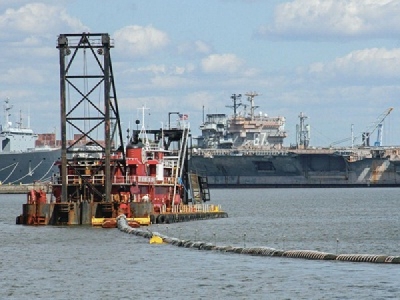
Posted on June 26, 2017
By Tony West, Philadelphia Public Record
It will have taken 35 years to move five feet in the Delaware River – but they are five big feet. Five feet deeper.
By this time next year, the channel-deepening project will have been completed. From an initial study by the Delaware River Port Authority in 1983, this project has consumed the attention of congressmen in Washington, the US Army Corps of Engineers, three state governments and numerous public, industry and labor collaborators. Soon, a new 45-foot channel stretching from Philadelphia and Camden to the mouth of the Delaware Bay will be funneling new business into our area.
Work began on the actual dredging in 2010, sponsored by Philadelphia Regional Port Authority (now PhilaPort). It has progressed in stages, each one fueled by new rounds of federal and state funding. None of these dollars were guaranteed; PhilaPort was always in competition with other hungry mouths competing for scarce public investment dollars. Last year, the channel-deepening was predicted to finish at a total of $364.3 million – two-thirds from the US government and one-third from the Commonwealth of Pennsylvania.
Ed Voigt has served in the US Army Corps of Engineers’ Philadelphia District since 1995, today as chief of public and legislative affairs. This spring, he sat down with the Public Record to review the project’s history and chart its final course.
Maintenance dredging is a permanent activity at every port, the equivalent of sweeping and clearing for highway maintenance. “Nature shoals, man dredges,” Voigt noted. But enlarging a channel is a different matter. The river that could easily accommodate bustling maritime commerce in 1776 needed to be expanded as ships grew bigger. By World War II, it had grown to a 40-foot depth – all the U.S. Navy needed for its greatest ships then.
Today, the Panama Canal has been expanded to a 50-foot depth. Many cargo vessels are now behemoths. They carry the future of global trade. If the Delaware River ports had remained stuck at 40 feet, they would have faded into insignificance, beat out by deeper nearby rivals.
It took consolidated, sustained, bipartisan action both to obtain the necessary federal funding each year and to work through the process that culminated in a project partnership agreement with PhilaPort as the project’s non-federal sponsor.
“Nature shoals, man dredges,” commented Ed Voigt, who has worked with the US Army Corps of Engineers for 22 years.
The Army Corps of Engineers is relied on to make cost-benefit analyses on which these budget battles turn. However, Voigt said, as a nationally funded public body, USACE cannot base its calculations on what would boost the local economy; Philadelphia’s gain might be New York’s loss, after all. It needed to calculate what advantage to the overall national economy deepening the Delaware would deliver. And it is required to be conservative in its estimates: It cannot include secondary benefits or forecast trade growth in its reckoning.
The Corps did its calculations and the Delaware River channel won. Projects need a benefit-cost ratio of more than 1.00 (which would be break-even) to move forward; this channel deepening came in at 1.65.
“A key factor,” said Voigt, “was that increasing channel depth increases cargo efficiency. If the same tanker makes the same trip to the same refinery, but can bring in 20% more oil, the nation as a whole benefits.”
By this time next year, PhilaPort will enjoy a 45-foot channel. Port businesses are already scouring the planet for new action. Their work will impact the hundreds of private and public entities that are involved in a complex and valuable web of economic interactions.
The Corps is not allowed to factor in long-term business macrodevelopments because, well, who knows what the future may bring? In its early days, when Sunoco ruled the waves of the Delaware, the outlook was for 80% of the economic benefits to come from expanded oil shipments and 20% from expanded container and bulk cargo. Today, post-Panamax, those numbers have been turned on their heads: now it’s closer to 80% from containers and bulk cargo and 20% from oil.
Ten different contracts comprise the actual deepening work. Seven were complete as of last year. The eighth contract was scheduled to be finished by the winter of 2016-17 but will have to be finished next winter as, for environmental reasons, it can only be conducted between December and March. It deals with a stretch between Chester, Pa. and Claymont, Del. where rock-blasting was required and where the amount to be blasted has turned out to be more than the best initial estimates, Voigt said.
The ninth contract will cover a stretch in the Delaware Bay called “Upper Reach E.” It has been awarded, with work to start this summer. Hopper dredging will be used to vacuum sand from the channel bottom and transport it to an upstream disposal site.
The tenth contract, for “Upper Reach B” between Chester and Wilmington, has just been advertised. A contractor should be in place and ready to start this fall. A combination of pipeline and bucket dredging is called for here.
Once the channel deepening is done, the Corps can go back to business as usual, routinely sweeping the underwater highway that places Philadelphia at the center of the world.
Source: Philadelphia Public Record





